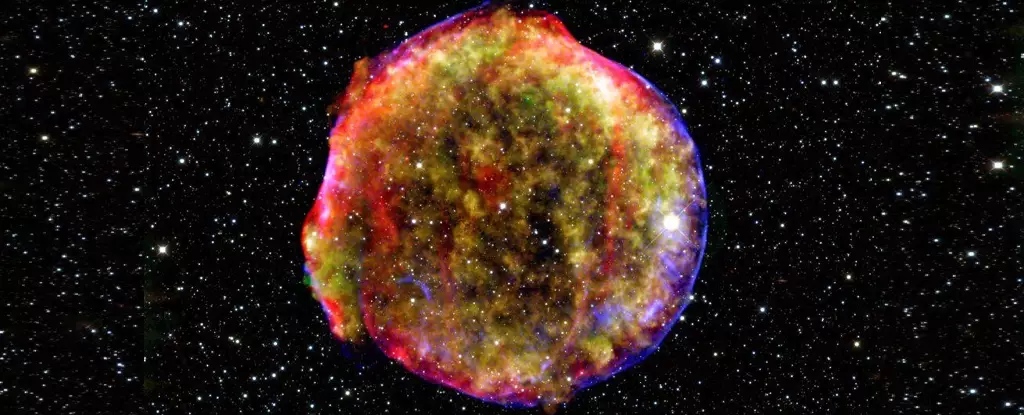In the vast expanse of our galaxy, incredible phenomena unfold, showcasing the elegance and brutality of the universe. Among these cosmic wonders, supernovae stand out as pivotal players in the life cycle of stars, embodying the duality of creation and destruction. For over a century, scientists have grappled with the enigma of cosmic rays—those elusive particles that bombard Earth from the depths of space. The prevailing theory has long suggested that supernovae could be the engines driving these energetic particles to astonishing velocities, approaching the speed of light. Yet, recent analysis adds layers of complexity to this narrative, moving us closer to understanding—while simultaneously clouding the certainty that was once assumed.
Radical New Perspectives on an Old Theory
Recent numerical simulations from an eclectic mix of physicists cast a renewed spotlight on supernovae, particularly focusing on their capacity to serve as natural accelerators. The classic view, built upon the spectacular explosion of a dying star, is that during this cataclysmic event, a supernova can create conditions ripe for the acceleration of cosmic rays. However, skepticism reigns among scholars, fueled by findings that suggest the emitted magnetic fields may not be as powerful as previously thought. This led some to conclude that the role of supernova remnants as sources of ultra-high-energy cosmic rays could be overstated.
Yet, the research presents us with a tantalizing thesis: the moments immediately following a supernova hold substantial potential for particle acceleration, albeit for a limited time. The researchers propose that these brilliant flashes of stellar destruction may act as temporary yet extraordinary cosmic accelerators, inviting us to reconsider the life of stars not merely in terms of lifetimes but in terms of the temporal nature of their explosive aftermaths.
Cosmic Rays: The Real Deal or Just Speculation?
Every so often, Earth is graced—or perhaps cursed—by a bombardment of particles that are incomprehensibly more powerful than anything our human ingenuity could conjure. These peta-electronvolt (PeV) particles challenge our understanding of physics and the sources from which they may arise. It’s here that the conversation shifts from mere speculation to the pursuit of truth. The ominously termed “PeVatrons” are hypothesized engines that might explain these ultra-energetic particles.
While the intriguing link between dying stars and PeVatrons offers a seductive narrative, it begs the question: Are we prepared to identify these celestial phenomena accurately? The answers lie not just in the fancies of theoretical astrophysics but in rigorous empirical evidence. As the researchers note, the timing of a supernova’s vigor is paramount to its potential to produce PeV-level energies. This assertion highlights the tragic irony of stellar death—a dying star could ignite a cosmic event that takes centuries for humanity to fully appreciate, but if it does not occur within the appropriate timeframe, its grandeur may go unseen.
The Fragility of Cosmic Balances
This profound interplay raises critical implications for our understanding of the universe as a whole. It reflects scenarios where the cosmos operates on a knife’s edge, dictating reactions based on timing and environmental conditions that we can barely comprehend. Tycho’s star provides a historical context, casting a long shadow of “what could have been” had stars like it exploded a few centuries later—perhaps providing humanity a clearer view of our celestial neighbors and the particles that lace our skies.
The dynamic cosmos epitomizes a race against time, where opportunities can slip away, unseen, just as they manifest. This cosmic fragility punctuates scientific inquiry, demanding a blend of theoretical foresight and technological advancement. Merging these realms opens new avenues for research, each unearthing more questions than answers. It reminds us of our limitations as observers in a universe that is infinitely larger and older than ourselves.
The Quest for Understanding and Collaboration
As scientists endeavor to peel back the layers of cosmic mystery, collaboration across disciplines becomes paramount. It underscores the necessity of integrating modern technology with innovative theoretical frameworks. The questions surrounding these celestial processes highlight the collective human experience of curiosity, reminding us that our pursuit of knowledge is intertwined with the very fabric of existence itself.
In the end, the exploration of supernovae as repositories of cosmic ray generation challenges us to dig deeper into the cosmic history residing within our galaxy. The story is not just about the particles themselves but rather the very nature of discovery, revealing the profound interconnectedness of the universe, urging us to reflect on our own place within this grand tableau.


Leave a Reply